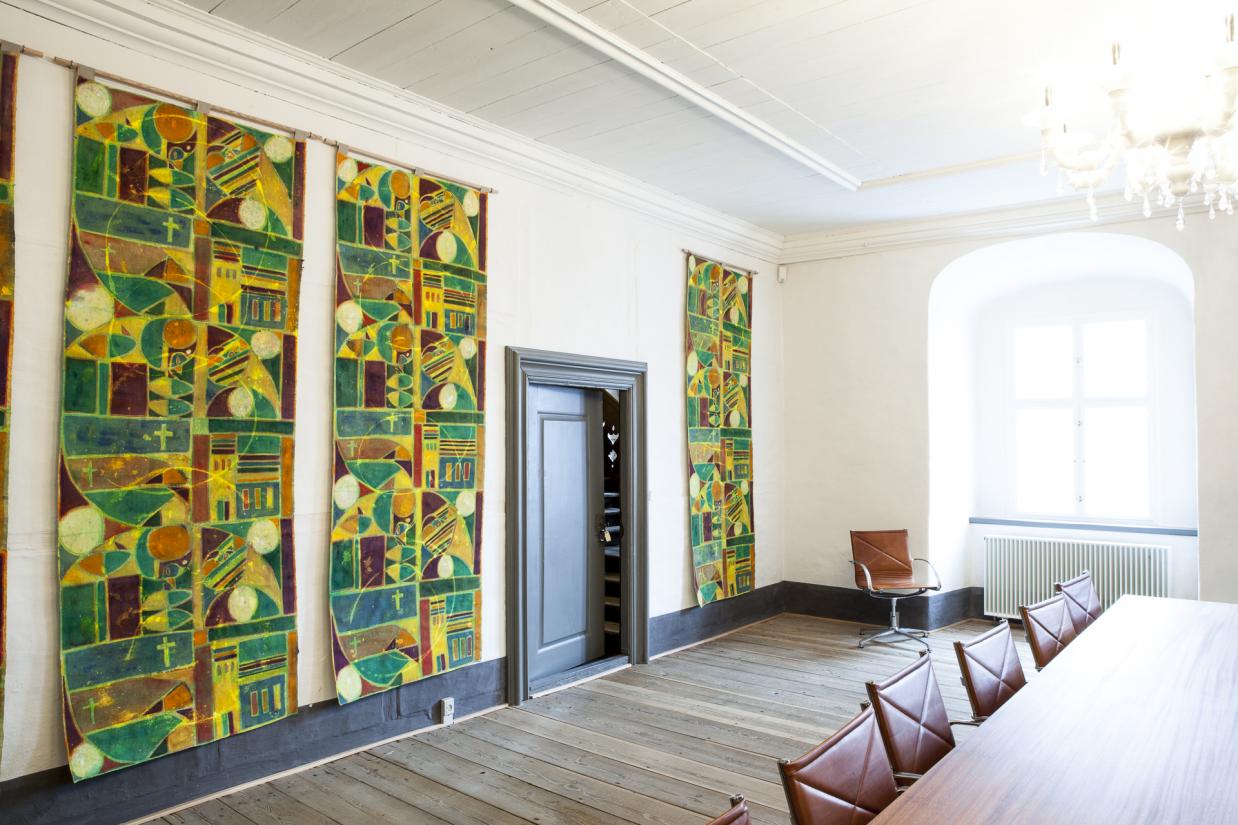In 2013, the listed building was taken over by the University of Southern Denmark, which uses it for offices, lectures and official or social events. With funding from the New Carlsberg Foundation, the artist Alexander Tovborg has decorated the building’s most famous room, Karen Brahe’s Library, which currently serves as the university boardroom, among other purposes.
A unique history
Odense Adelige Jomfrukloster is one of Denmark’s oldest secular buildings with a history dating back to the early 1500s, when it was commissioned as a bishop’s mansion by Bishop Jens Andersen. Over the following years, the building changed hands repeatedly until it was eventually taken over by the noblewoman Karen Brahe, who in 1716 drew up a charter designating it a home for unmarried ladies of rank. Now, the building was to serve as a home for unmarried noblewomen and a prioress. In addition, it also housed a valuable collection with thousands of books and manuscripts established by the building’s former owner, Karen Brahe’s great aunt, the noblewoman Anne Gøye.
The historical architectural layers of the building are well preserved and bear testimony to its unique past. The architecture and interior are a cavalcade of historical styles, ranging from the cross-vaulted ceilings of the late Middle Ages to decorations in the form of wallpapers, murals and panels from the 1700s and 1800s. Among these architectural elements, Karen Brahe’s library on the ground floor stands out with an impressive Renaissance fireplace from 1673, and thanks to the extensive restoration carried out by Realdania By & Byg, the building now serves as a fully functioning location for the University of Southern Denmark.
Repetition and dissolution
In a dialogue with the University of Southern Denmark, the New Carlsberg Foundation invited Alexander Tovborg to create a site-specific decoration for Karen Brahe’s Library. The result is the Karen Bille Brahe tapestries, a series consisting of four hand-woven tapestries with a recurring painted pattern. Tovborg comments,
‘The tapestries were created in cooperation with a weaving studio, hand-woven in cotton and linen using a special technique that was popular in the 1700s. In Karen Brahe’s own time, the room was also decorated with tapestries, and in that way the medium creates a link between the past and the presence.’
On the tapestries, Tovborg has painted a motif based on abstract geometric shapes in a contrast-rich palette interrupted by individual cross symbols. Rather than applying a stringent idiom, the lines and forms of the pattern vary with each repetition. At first glance, the tapestries appear almost identical, but a closer inspection quickly reveals that this is far from the case. Tovborg says,
‘It does something interesting to a motif when it is repeated. It dissolves to become ornamental and decorative.’
Thus, the series not only contains references to the past; according to Tovborg, in its transition from repetition to dissolution the piece reflects the building’s richly facetted history and the countless memories that it carries:
‘Originally, it was a bishop’s mansion, then it became a place intended to keep the ladies of the aristocracy and the wealthy classes out of trouble. Later, it became the women’s home, and today it is used by the University of Southern Denmark and functions as meeting rooms. Does a room change with history and the varying functions it serves? How do we even remember a place?’
Henrik Dam, vice-chancellor of the University of Southern Denmark, is pleased with the decoration of Karen Brahe’s Library:
‘We have received many positive comments about Tovborg’s work. It adds an aesthetic element that brings warmth to a room that previously had a slightly “cold” feel, but in addition, it also frames the building’s history in a way that makes it relevant to the present .’
![Alexander Tovborg: Karen Bille Brahe tæpperne [The Karen Bille Brahe Tapestries], 2015. Odense Adelige Jomfrukloster (SDU)](/sites/default/files/styles/subpage_hero/public/2018-04/Adelige_kloster-5_0.jpg?h=7c632d76&itok=ElFwyc9a)

![Alexander Tovborg: Karen Bille Brahe tæpperne [The Karen Bille Brahe Tapestries], 2015. Odense Adelige Jomfrukloster (SDU)](/sites/default/files/styles/slider_full/public/2018-04/Adelige_kloster_0.jpg?itok=UxeaPkr8)
![Alexander Tovborg: Karen Bille Brahe tæpperne [The Karen Bille Brahe Tapestries], 2015. Odense Adelige Jomfrukloster (SDU)](/sites/default/files/styles/slider_full/public/2018-04/Adelige_kloster-3_0.jpg?itok=iv1jxqVZ)
![Alexander Tovborg. Karen Bille Brahe tæpperne [The Karen Bille Brahe Tapestries], 2015. Odense Adelige Jomfrukloster (SDU)](/sites/default/files/styles/slider_full/public/2018-04/Adelige_kloster-8_0.jpg?itok=h5qMCW8L)


